 Imperial Japanese Navy Submarine, Air Base
Imperial Japanese Navy Submarine, Air Base
and Marine Oil Terminal at Sabang, Sumatra
By Bob Hackett with Sander Kingsepp
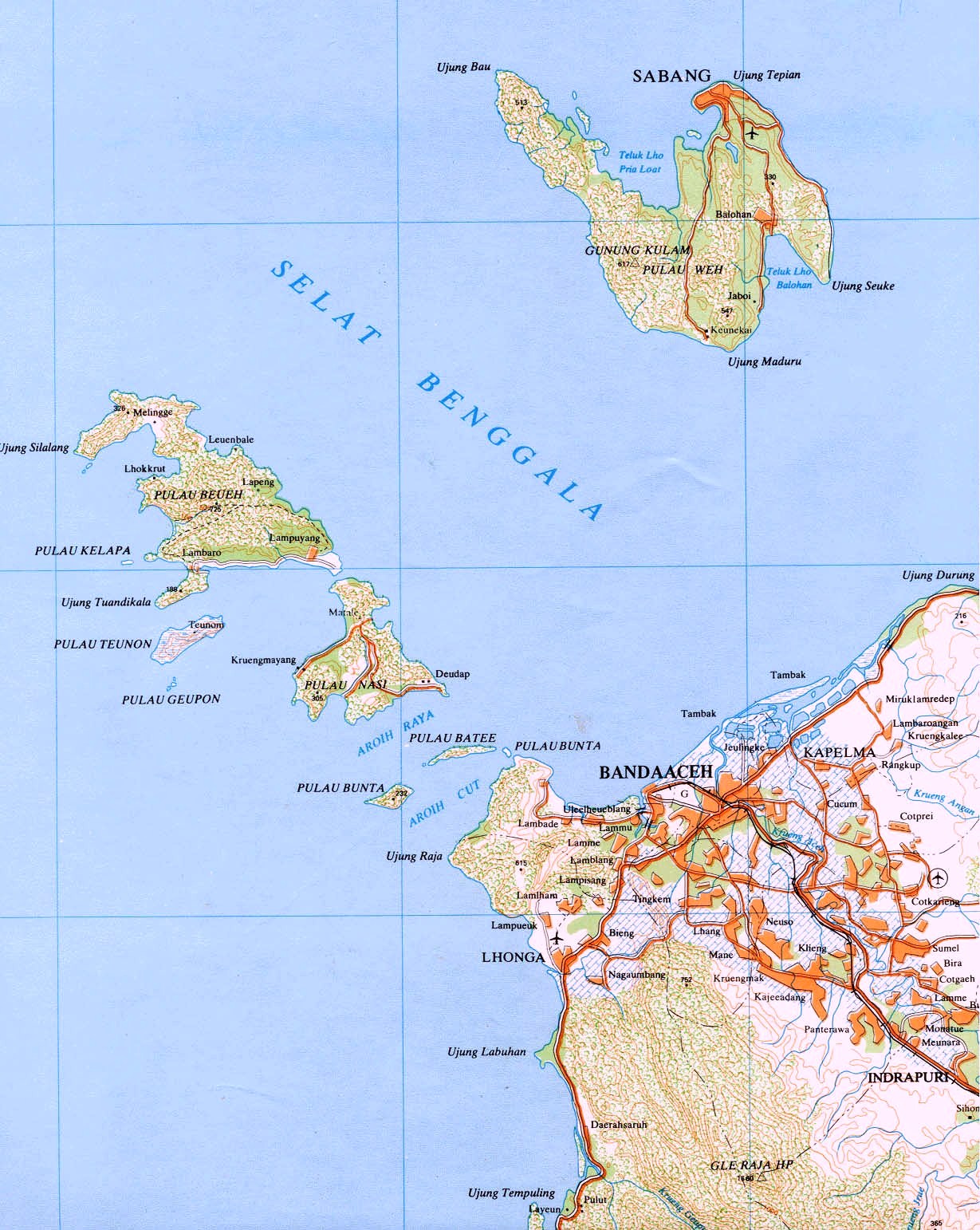
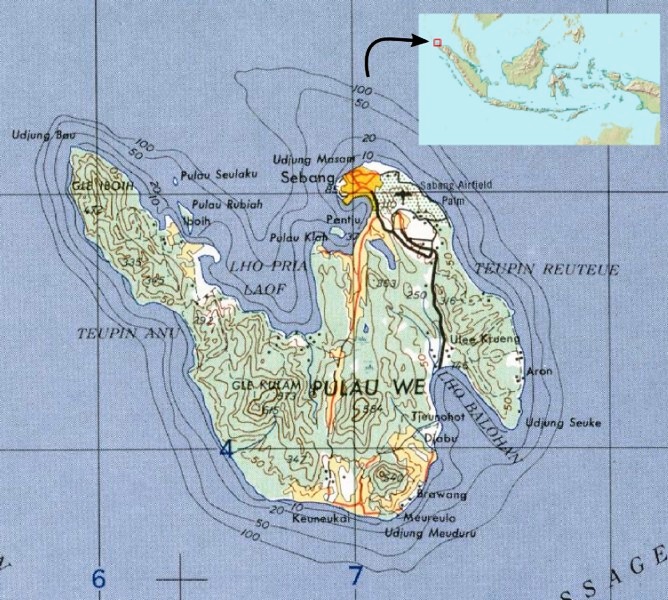 Left-Map of northernmost Sumatra Showing Sabang on Weh
Island and nearby Banda Aceh
Left-Map of northernmost Sumatra Showing Sabang on Weh
Island and nearby Banda Aceh
Right-Map Showing Weh Island and inset showing
relation to Sumatra, Malaya, Java, Borneo and Celebes
© Bob Hackett February 2016
Revision 4
During World War II, the Japanese Navy controlled the former Royal Dutch Shell oil storage facilities at Sabang Naval Base. Sabang consists of Weh Island and several smaller islands off the northern tip of Sumatra. The islands lie about 10 1/2 miles north of Banda Aceh. (On 26 December 2004, a magnitude 9.3 earthquake struck off the western coast of Sumatra. Banda Aceh, the closest major city to the quake's epicenter, suffered further damage when a tsunami struck shortly afterward and killled 167,000 people.)
On 9-10 March 1942, IJNAF bombers of the Mihoro Naval Air Group (NAG) from Penang carried out softening-up strikes against Sabang.
On 10 March 1942, the Japanese launched “Operation T”- the Invasion of Northern Sumatra. Nine transports carrying the main body of the Imperial Guards Division escorted by minelayer HATSUTAKA, subchaser CH-7 and the 1st Section, 44th Minesweeper Division departed West Harbor, Singapore. At 2030 (JST), 11 March, the transports were divided into the Sabang/Idi Group conisting of TATSUMIYA, KINUGAWA and HEITO MARUs and at 0005, the transports entered their assigned landing places. At 0100 on 12 March, unopposed landings were made by the
Kobayashi Detachment of the Imperial Guards.
Beginning in March 1942, Sabang was used as a base for Kawanishi H6K "Mavis" Type 97 flying boats of the Toko Kokutai (NAG). On 23 March, seven (later 18) H6Ks arrived at Port Blair, Andaman Islands from Sabang and began flying reconnaissance missions in the Indian Ocean. A week later, several H6Ks flew 700 miles from Port Blair to reconnoiter Ceylon as part of the IJN's Operation "C" raids in the Indian Ocean.
On 22 March 1942, the first IJNAF land-based bombers of the Mihoro NAG arrived at Sabang and commenced patrols over the Strait of Malacca and the Indian Ocean. That same month, Mitsubishi Type 1 "Betty" G4M1 bombers and the Mitsubishi Type 96 "Claude"A5M fighter detachment of the Kanoya NAG launched patrols from Sabang.
As of 14 July 1942, the 1st Southern Expeditionary Fleet’s 9th Base Force at Sabang included the 9th Guard Unit, 9th Signals Unit, 11th Submarine Base Unit, 91st Subchaser Division, 44th Minesweeper Division, minelayer HATSUTAKA and gunboat EIKO MARU. That same month, destroyers IJN MURAKUMO and YUGIRI arrived at Sabang from Amami-O-Shima, Ryukyus via Mako, Pescadores and Singapore en route to Mergui, Burma for Indian Ocean raiding operations (aborted due to Guadalcanal).
In late July 1942, pending the activation of another “Operation C”, the IJN decided to provide additional fighter cover for their base at Port Blair. Captain Miura Kanzo’s (47) Toko NAG detachment’s flying boats were tasked with long-range reconnaissance in the Bay of Bengal as far as Trincomalee and the Kanoya NAG was tasked to provide three A5M fighters from their base at Sabang.
In August 1942, the Dutch 4th Flotilla's Ltz I Albertus M. Valkenburg's submarine Hr.Ms. O-23, based in Colombo, Ceylon and under British Eastern Fleet 's operational control, was ordered to transit Weh Island to conduct a reconnaissance off Sabang on her return to Colombo.
On 3 August 1942, upon their arrival at Port Blair from Sabang, the three Kanoya NAG A5M fighters come under the operational control of Captain Miura's Toko NAG. On 14 August, after the cancellation of Operation C because of the American landings at Tulagi/Guadalcanal, the A5Ms left Port Blair for Sabang where they returned under command of the Kanoya NAG.
On 10 August 1942, light cruiser IJN ISUZU arrived at Sabang from Mergui, Burma (Myanmar), refueled and departed the next day for Penang Island, Malaya followed on 15 August by light training cruiser IJN KASHII that arrived at Sabang from Port Blair, probably refueled and departed the next day for Penang.
On 3 September 1942, the first detachment of the Kanoya NAG departed Sabang airfield for Kavieng, New Ireland to participate in the Guadalcanal campaign. The 936th NAG (former 40th NAG) arrived as a replacement soon after.
In October 1942, destroyer IJN KARI escorted convoys from Port Blair to Sabang. On 31 January 1943, she resumed Sabang-Andamans patrol/escort duties.
On 11 December 1942, KASHII arrived at Sabang from Port Blair, probably refueled and departed two days later for Sibolga, W. Sumatra where her sailors formed a 58-man Special Naval Landing Force (SNLF) to support Army units on the Mentawai islands. On 18 December 1942, KASHII departed Sibolga for Sabang. She arrived the next day and remained until 23 December 1942 when she departed, arriving at Batavia, Java (Jakarta, Indonesia) that day.
20 December 1942: British Operation “Minerva”:
Two PBY “Catalina” seaplanes of 205 Squadron, Royal Air Force (RAF) from Ceylon (now Sri Lanka) separately attack Sabang. Both do a brief recce and then descend to 40 feet for a run over the harbor, firing their machine guns and each dropping their six 250lb bombs. Both planes are
fired at, probably by ships. One is hit numerous times and bounces off the sea, but the pilot regains control, and climbs away to return to Ceylon, most of it on one engine because the other was hit by ground fire. The other PBY does
a similar run over the harbor, also comes under fire, but is not hit. Another PBY, of 413 Squadron Royal Air Canadian Force (RCAF), flies from Ceylon and looks for Lho-Nga airfield, but can not find it in the darkness, so flies on to
Kota Raja (now Bandar Aceh), drops its bombs and returns to Ceylon. [1]
On 24 April 1943, Ltz I Johannes F. van Dulm's Dutch submarine Hr.Ms. O-21 conducted a reconnaissance mission in the Bay of Sabang, followed on 15 May by Ltz II W. J. de Vries's submarine Hr.Ms. O-24 that also reconnoitered Sabang.
On 8 May 1943, IJN submarine I-29 debarks revolutionist Subhas Chandra Bose, Chief (Netaji) of the anti-British Indian National Army of Liberation (Azad Hind Fauj) and his aide Major Dr. Habib Hassan, a former Oxford student, at Weh Island.
On 28 May 1943, IJN KASHII departed Sibolga for Sabang. She arrived the next day, probably refueled and departed the next day for Car Nicobar, Andaman Islands arriving there on 31 May.
On 9 July 1943, Italian submarine COMANDANTE ALFREDO CAPPELLINI (code named AQUILA III) arrived at Sabang from the Regia Marina's "Betasom" (Beta sommergibili or B-submarine) base at Bordeaux, France with almost empty fuel tanks. She was the first Italian submarine to reach the Far East. At Sabang, she joined the Italian colonial sloop ERITREA.
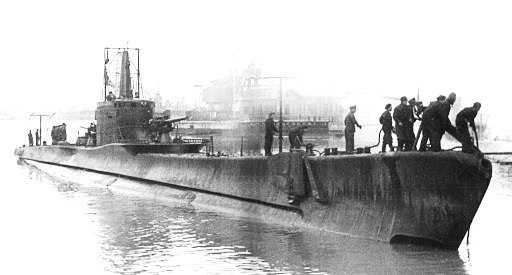 COMANDANTE ALFREDO CAPPELLINI
On 12 August 1943, Italian submarine LUIGI TORELLI (coded named AQUILA VI) en route to Sngapore from Bordeaux was about to run out of fuel in the Indian Ocean, but rendezvoused successfully with German U-178 that transfered diesel oil to her. Thereafter, they headed eastward together.
On 25 August 1943, Rear Admiral (later Vice Admiral) Hiraoka Kumeichi moved his 9th Base Force HQ from Penang to
Sabang which signalled its new importance as a major naval base.
On 26 August 1943, TORELLI and U-178 arrived at Sabang where they refuelled and departed for Penang, home of the "Monsun" U-boat Group arriving there on 29 August.
On 27 August 1943, KASHII departed Singapore for Sabang on a transport run carrying troops and supplies. On 29 August off Weh Island, she was attacked by British submarine HMS TRIDENT, but was missed by all eight torpedoes TRIDENT fired.
In September 1943, an airstrip was completed at Lho Nga airfield near Kutaradja with two 4,921x328 ft (1500x100m) and 3,927x64 ft (1200x50m) runways. Barracks and other facilities were constructed to accomodate 4,700 men. The base was then used by Mitsubishi
G4M “Betty” bombers for reconnaissance, anti-submarine patrols and convoy escort missions. Lho Nga (Lho’nga) airfield had been built prewar by the Dutch and used as refueling point by Boeing B-17s, LB-30s and Bristol "Blenheim" bombers enroute to Java from India and Burma.
COMANDANTE ALFREDO CAPPELLINI
On 12 August 1943, Italian submarine LUIGI TORELLI (coded named AQUILA VI) en route to Sngapore from Bordeaux was about to run out of fuel in the Indian Ocean, but rendezvoused successfully with German U-178 that transfered diesel oil to her. Thereafter, they headed eastward together.
On 25 August 1943, Rear Admiral (later Vice Admiral) Hiraoka Kumeichi moved his 9th Base Force HQ from Penang to
Sabang which signalled its new importance as a major naval base.
On 26 August 1943, TORELLI and U-178 arrived at Sabang where they refuelled and departed for Penang, home of the "Monsun" U-boat Group arriving there on 29 August.
On 27 August 1943, KASHII departed Singapore for Sabang on a transport run carrying troops and supplies. On 29 August off Weh Island, she was attacked by British submarine HMS TRIDENT, but was missed by all eight torpedoes TRIDENT fired.
In September 1943, an airstrip was completed at Lho Nga airfield near Kutaradja with two 4,921x328 ft (1500x100m) and 3,927x64 ft (1200x50m) runways. Barracks and other facilities were constructed to accomodate 4,700 men. The base was then used by Mitsubishi
G4M “Betty” bombers for reconnaissance, anti-submarine patrols and convoy escort missions. Lho Nga (Lho’nga) airfield had been built prewar by the Dutch and used as refueling point by Boeing B-17s, LB-30s and Bristol "Blenheim" bombers enroute to Java from India and Burma.
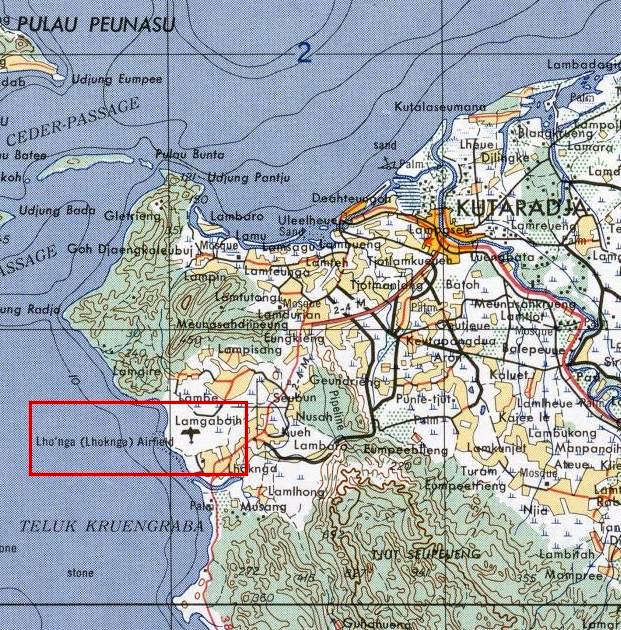 Location of Lho Nga airfield on the north tip of Sumatra
On 8th September 1943, at 0200 (local), the Italian sloop R. N. ERITREA was en route to Sabang from Singapore to support submarine CAPPELLINI, but as soon as the message about the surrender of Italy was picked up, ERITREA changed course heading at full speed for the British Naval Base at Columbo, Ceylon (Sri Lanka). After receiving the news of the armistice signed by the Italian government, Vice Admiral Hiraoka at Sabang, ordered CAPPELLINI (later UIT-24/I-503) and her crew seized. Later, the Japanese handed over the submarine to the Germans.
In October 1943, IJN submarines I-162 and I-166 arrived at Sabang from Penang, refueled then departed for the Indian Ocean on war patrols.
On 11 October 1943, an erroneous report about an approaching British Task Force was received at Sabang. The 753rd NAG (former Takao NAG) transfered a detachment to Sabang to detect it.
In 1944, the United States requested the British Eastern Fleet to conduct a raid in the Sumatra area as a distraction from their American operations on Hollandia (now Jayapura), New Guinea. The British fleet commander, Admiral (later Admiral of the Fleet, Sir) James F. Somerville’s (former CO of HMS NORFOLK) selected Sabang for its location at the entrance to the Malacca Strait and its strategic installations, such as a radar station, port port and oil facilities and airfields. At this time, Japanese forces in Burma were under pressure and suffering serious supply problems. The Sabang raid was expected to exacerbate the Japanese's problems and thereby assist the British 14th Army.
In February 1944, Rear Admiral (later Vice Admiral) Hirose Sueto (39)(former CO of AOBA) assumed command of the 9th Base Force at Sabang.
On 23 February 1944, KARI arrived at Sabang from Nancowry, Nicobar Islands, probably refueled and departed the same day.
On 4 March 1944, USS SARATOGA (CV-3) departed the USN's Majuro, Marshall Islands anchorage to reinforce the British Eastern Fleet and allow it to attack Japanese-controlled territory. Escorted by destroyers USS CUMMINGS (DD-365), USS DUNLAP (DD-384) and USS FANNING (DD-385), the small American Task Group 58.4 steamed via Espiritu Santo, New Hebrides, Hobart, Tasmania and Fremantle, Australia to join the British in the Indian Ocean.
On 27 March 1944, SARATOGA rendezvoused with the British force at sea composed of carrier HMS ILLUSTRIOUS and four battleships with destroyer escorts.
On 31 March 1944, SARATOGA and the British force arrived at Trincomalee, Ceylon (Sri Lanka). During the next two weeks, carriers SARATOGA and HMS ILLUSTRIOUS conducted intensive training for an attack on Sabang.
Location of Lho Nga airfield on the north tip of Sumatra
On 8th September 1943, at 0200 (local), the Italian sloop R. N. ERITREA was en route to Sabang from Singapore to support submarine CAPPELLINI, but as soon as the message about the surrender of Italy was picked up, ERITREA changed course heading at full speed for the British Naval Base at Columbo, Ceylon (Sri Lanka). After receiving the news of the armistice signed by the Italian government, Vice Admiral Hiraoka at Sabang, ordered CAPPELLINI (later UIT-24/I-503) and her crew seized. Later, the Japanese handed over the submarine to the Germans.
In October 1943, IJN submarines I-162 and I-166 arrived at Sabang from Penang, refueled then departed for the Indian Ocean on war patrols.
On 11 October 1943, an erroneous report about an approaching British Task Force was received at Sabang. The 753rd NAG (former Takao NAG) transfered a detachment to Sabang to detect it.
In 1944, the United States requested the British Eastern Fleet to conduct a raid in the Sumatra area as a distraction from their American operations on Hollandia (now Jayapura), New Guinea. The British fleet commander, Admiral (later Admiral of the Fleet, Sir) James F. Somerville’s (former CO of HMS NORFOLK) selected Sabang for its location at the entrance to the Malacca Strait and its strategic installations, such as a radar station, port port and oil facilities and airfields. At this time, Japanese forces in Burma were under pressure and suffering serious supply problems. The Sabang raid was expected to exacerbate the Japanese's problems and thereby assist the British 14th Army.
In February 1944, Rear Admiral (later Vice Admiral) Hirose Sueto (39)(former CO of AOBA) assumed command of the 9th Base Force at Sabang.
On 23 February 1944, KARI arrived at Sabang from Nancowry, Nicobar Islands, probably refueled and departed the same day.
On 4 March 1944, USS SARATOGA (CV-3) departed the USN's Majuro, Marshall Islands anchorage to reinforce the British Eastern Fleet and allow it to attack Japanese-controlled territory. Escorted by destroyers USS CUMMINGS (DD-365), USS DUNLAP (DD-384) and USS FANNING (DD-385), the small American Task Group 58.4 steamed via Espiritu Santo, New Hebrides, Hobart, Tasmania and Fremantle, Australia to join the British in the Indian Ocean.
On 27 March 1944, SARATOGA rendezvoused with the British force at sea composed of carrier HMS ILLUSTRIOUS and four battleships with destroyer escorts.
On 31 March 1944, SARATOGA and the British force arrived at Trincomalee, Ceylon (Sri Lanka). During the next two weeks, carriers SARATOGA and HMS ILLUSTRIOUS conducted intensive training for an attack on Sabang.
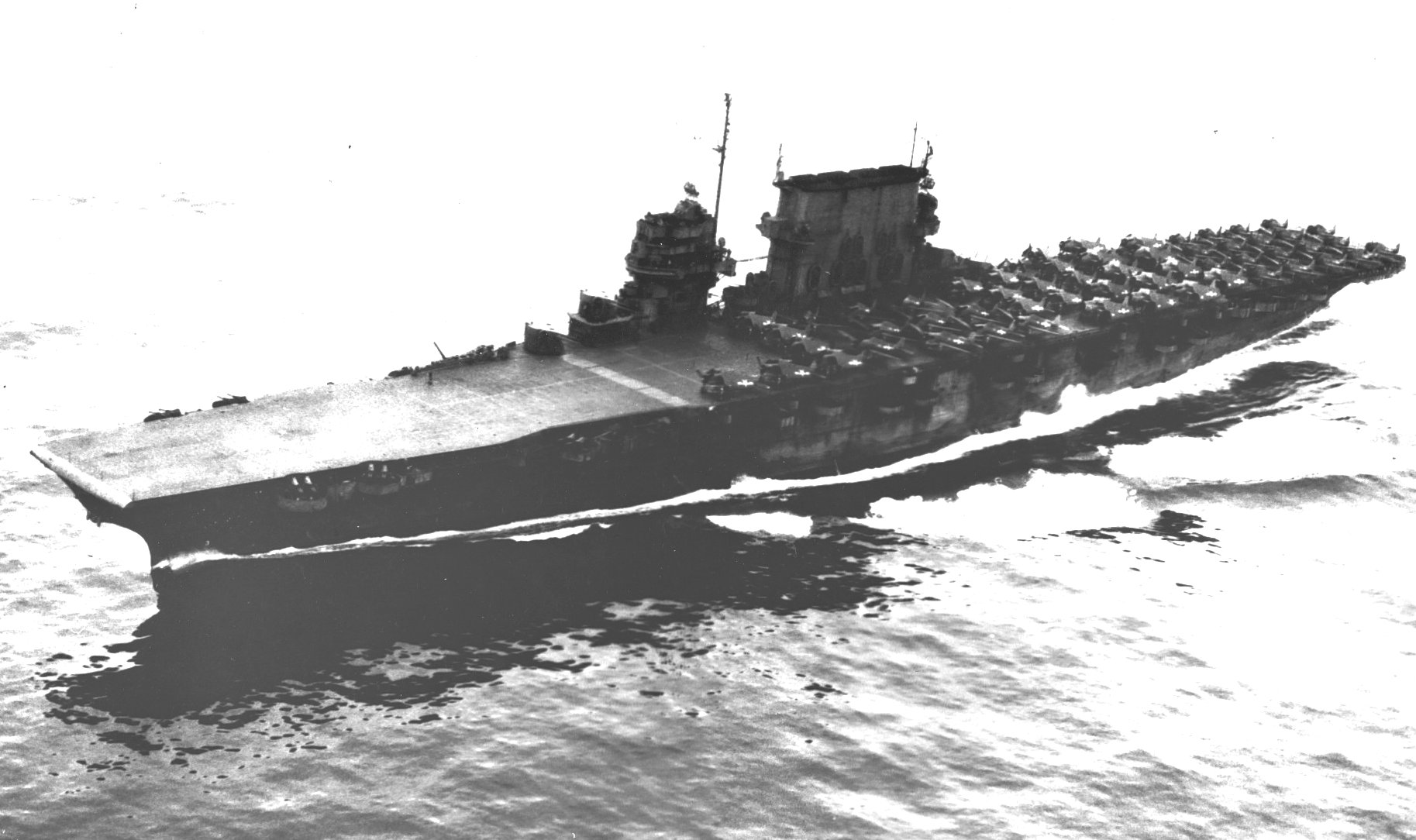
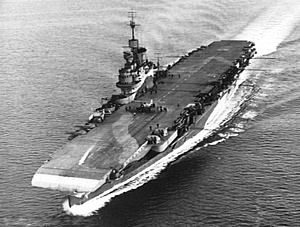 Left-USS SARATOGA Right-HMS ILLUSTRIOUS
Left-USS SARATOGA Right-HMS ILLUSTRIOUS
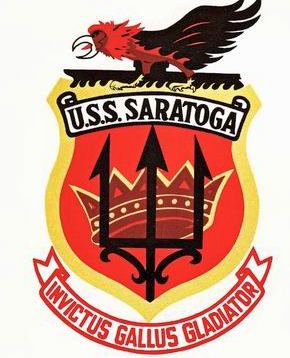
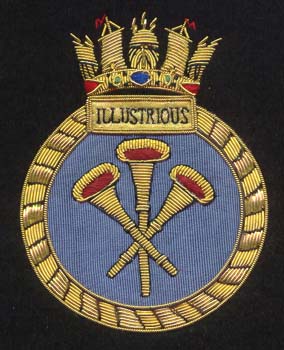 Left-USS SARATOGA (CV-3) Crest Right-HMS ILLUSTRIOUS Crest
On 12 April 1944, Free French battleship RICHELIEU arrived at Trincomalee and joined the British Eastern Fleet.
On 16 April 1944, Admiral (later Admiral of the Fleet, Sir) James F. Somerville’s (former CO of HMS NORFOLK) British Task Force 69 departed Trincomalee, Ceylon (Sri Lanka) consisting of battleships HMS QUEEN ELISABETH, HMS VALIANT and French RICHELIEU, cruisers HMS NEWCASTLE, HMS NIGERIA, HMS CEYLON, HMNZS GAMBIA and Dutch Hr.Ms. TROMP and destroyers HMS ROTTERHAM, HMS RACEHORSE, HMS PENN, HMS PETARD, Dutch Hr.Ms. VAN GALEN, HMAS NAPIER, HMAS NEPAL, HMAS NIZAM and HMAS QUIBERON joined by Vice Admiral (later Admiral of the Fleet/Sir) Arthur J. Power's (former CO of ARK ROYAL) Task Force 70 consisting
of carriers HMS ILLUSTRIOUS and USS SARATOGA (CV-3), battlecruiser HMS RENOWN, cruisers HMS CEYLON and HMNZS GAMBIA and destroyers HMS QUILLIAM, HMS QUADRANT, HMS QUEENBOROUGH, USS CUMMINGS, USS DUNLAP and USS FANNING.
On 18 April 1944, cruisers HMS CEYLON and HMNZS GAMBIA joined Task Force 70 at sea. That same day, minelayer IJN HATSUTAKA arrived at Sabang.
At 0530, 19 April 1944, Admiral Somerville launched Operation "COCKPIT". Seventeen Fairey Barracuda bombers and 13 Chance-Vought F4U Corsair fighters from HMS ILLUSTRIOUS and 11 Grumman TBM “Avenger” torpedo-bombers, 18 Douglas “Dauntless” dive-bombers and 24 Grumman F6F“Hellcat” fighters from USS SARATOGA attacked Sabang harbor and nearby Lho Nga airfield. The attack caught the Japanese by surprise and there was no fighter opposition.
The escorts strafed the airfield and destroyed between 21-30 aircraft on the ground. IJN transport KUNITSU MARU and IJA transport HARUNO MARU were hit and minelayer IJN HATSUTAKA strafed and set on fire. Three of her crew were KIA. A direct hit by a 1000-pound bomb set a large oil tank on fire. The power-station, barracks and wireless station also were badly damaged.
Left-USS SARATOGA (CV-3) Crest Right-HMS ILLUSTRIOUS Crest
On 12 April 1944, Free French battleship RICHELIEU arrived at Trincomalee and joined the British Eastern Fleet.
On 16 April 1944, Admiral (later Admiral of the Fleet, Sir) James F. Somerville’s (former CO of HMS NORFOLK) British Task Force 69 departed Trincomalee, Ceylon (Sri Lanka) consisting of battleships HMS QUEEN ELISABETH, HMS VALIANT and French RICHELIEU, cruisers HMS NEWCASTLE, HMS NIGERIA, HMS CEYLON, HMNZS GAMBIA and Dutch Hr.Ms. TROMP and destroyers HMS ROTTERHAM, HMS RACEHORSE, HMS PENN, HMS PETARD, Dutch Hr.Ms. VAN GALEN, HMAS NAPIER, HMAS NEPAL, HMAS NIZAM and HMAS QUIBERON joined by Vice Admiral (later Admiral of the Fleet/Sir) Arthur J. Power's (former CO of ARK ROYAL) Task Force 70 consisting
of carriers HMS ILLUSTRIOUS and USS SARATOGA (CV-3), battlecruiser HMS RENOWN, cruisers HMS CEYLON and HMNZS GAMBIA and destroyers HMS QUILLIAM, HMS QUADRANT, HMS QUEENBOROUGH, USS CUMMINGS, USS DUNLAP and USS FANNING.
On 18 April 1944, cruisers HMS CEYLON and HMNZS GAMBIA joined Task Force 70 at sea. That same day, minelayer IJN HATSUTAKA arrived at Sabang.
At 0530, 19 April 1944, Admiral Somerville launched Operation "COCKPIT". Seventeen Fairey Barracuda bombers and 13 Chance-Vought F4U Corsair fighters from HMS ILLUSTRIOUS and 11 Grumman TBM “Avenger” torpedo-bombers, 18 Douglas “Dauntless” dive-bombers and 24 Grumman F6F“Hellcat” fighters from USS SARATOGA attacked Sabang harbor and nearby Lho Nga airfield. The attack caught the Japanese by surprise and there was no fighter opposition.
The escorts strafed the airfield and destroyed between 21-30 aircraft on the ground. IJN transport KUNITSU MARU and IJA transport HARUNO MARU were hit and minelayer IJN HATSUTAKA strafed and set on fire. Three of her crew were KIA. A direct hit by a 1000-pound bomb set a large oil tank on fire. The power-station, barracks and wireless station also were badly damaged.
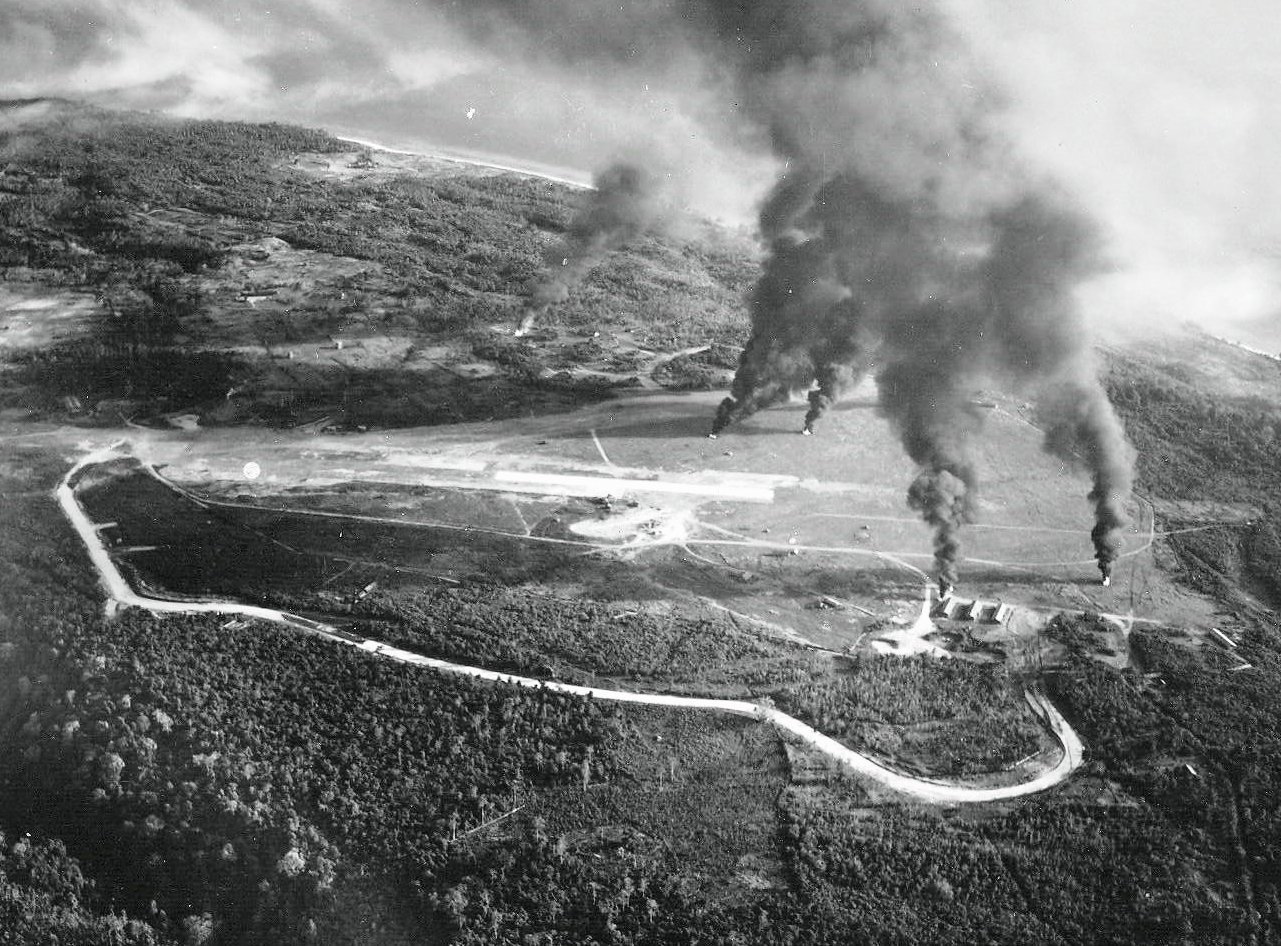 “Strike photo of Sabang airfield during Operation "COCKPIT"
Twelve American aircraft were hit by flak, but all except one Hellcat of VF-12 made it back to SARATOGA. The pilot was recovered by submarine HMS TACTICIAN, under Japanese fire. HATSUTAKA claimed two of the attackers shot down and a third damaged.
As the fleet was withdrawing, three Mitsubishi G4M “Betty” bombers attempted to attack, but the Hellcat combat air patrol shot down two and damaged the third. Hours after the fleet left the area, HMS TACTICIAN reported large fires in the dockyard still burning fiercely.
At 0955, HATSUTAKA departed Sabang for repairs and maintenance at Penang, arriving the next day.
“Strike photo of Sabang airfield during Operation "COCKPIT"
Twelve American aircraft were hit by flak, but all except one Hellcat of VF-12 made it back to SARATOGA. The pilot was recovered by submarine HMS TACTICIAN, under Japanese fire. HATSUTAKA claimed two of the attackers shot down and a third damaged.
As the fleet was withdrawing, three Mitsubishi G4M “Betty” bombers attempted to attack, but the Hellcat combat air patrol shot down two and damaged the third. Hours after the fleet left the area, HMS TACTICIAN reported large fires in the dockyard still burning fiercely.
At 0955, HATSUTAKA departed Sabang for repairs and maintenance at Penang, arriving the next day.
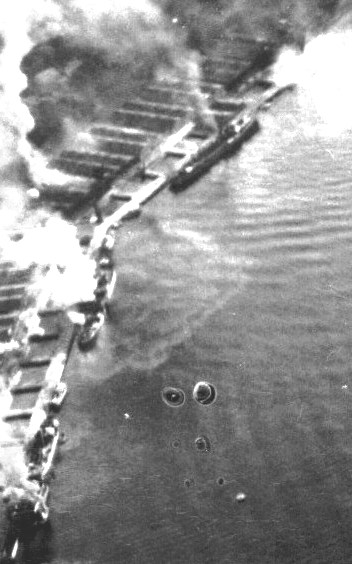
 Left-Minelayer HATSUTAKA at top and transports KUNITSU and HARUNO MARUs at left.
Left-Minelayer HATSUTAKA at top and transports KUNITSU and HARUNO MARUs at left.
Right-Ships and harbor facilities at Sabang on fire after being attacked by Allied aircraft during Operation "COCKPIT"
The destruction of oil installations and shipping at Sabang contributed to the cessation of Japanese offensives in the Arakan (now Rakhine) State, situated on the W coast of Burma.
Allied codebreakers decrypted a message dated 9 May 1944 from the Chief, 3rd Section, Imperial H.Q. Naval Staff, that stated he "estimated American naval strength in the attack on SABANG on 19/4/44 was from 2 to 3 auxiliary carriers of the 20 knot class, about 2 cruisers and from 3 to 4 destroyers. It was not known whether this force had been permanently assigned as an Indian Ocean Force nor if it was to be gradually strengthened”.
On 9 June 1944, Allied codebreakers decrypted a message sent by AirFlot 28 to unknown addressee F/i 1st Southern Expeditionary Fleet and S.W. Area Fleet dated 24/5/44: “ Para 1. All the aircraft which attacked KOTA RAJA No. 1 Base had U.S. markings and were F4F/s. A large formation was observed flying in the direction of SABANG, but it was impossible to make certain of their markings from KOTA RAJA. But before the large formation 2 (four-engined) flying boats (one of which was confirmed as British) were seen to fly off southwards after carrying out a bombing attack on SABANG. Para 2. No twin-engined bombers were seen. Para 3: With regard to the 3 missing aircraft in 705 Air Group’s type 97 torpedo-bomber unit which set off to attack: they took off at 1130. After two of them had sent HI HI HI at 1235 and 1305, touch was lost with them. Speed was 120. No clue was given in the enemy communiques after, but as it is considered that there was an enemy force where they were lost, it is considered very probable that they carried out a strong attack”. [2]
On 8 July 1944, Allied codebreakers decrypted a message sent on 20/5/44 by the Admiral Commanding AirFlot 28, reported to CoS. SW Area Fleet that, owing to the runway having been bombed, the SABANG Torpedo Adjusting Plant was being moved and erected 2000 metres away, the work being due to be completed at the beginning of June, but instructions had been received to abandon the work temporarily on account of the move of the factory. The KOTA RAJA Torpedo Adjusting Plant (capacity 9 torpedoes), was completed in March/44 and was in use. As it was necessary to retain the SABANG Adjustment Plant, and the present site was very [blank] (at the time of the raid it was partly bombed), it was urged that the work should be restarted”. [2]
On 22 July 1944, Admiral Somerville’s British Eastern Fleet departed Trincomalee consisting of carriers HMS ILLUSTRIOUS and HMS VICTORIOUS, battleships HMS QUEEN ELISABETH, HMS VALIANT and French RICHELIEU, battlecruiser HMS RENOWN, CruRon4's HMS CUMBERLAND, Dutch cruiser Hr.Ms. TROMP, HMS KENYA, HMS NIGERIA, HMS PHOEBE, HMS CEYLON, HMNZS GAMBIA and destroyers HMS QUILLIAM, HMS QUALITY, HMAS QUIKMATCH, HMS RACEHORSE, HMS RAIDER, HMS RAPID, HMS RELENTLESS,
HMS ROCKET, HMS ROEBUCK and HMS ROTTERHAM. Submarines HMS TEMPLAR and TANTIVY were employed for air-sea rescue.
On 25 July 1944, Admiral Somerville launched Operation "CRIMSON". Thirty-four Chance-Vought F4U "Corsair" fighters from HMS ILLUSTRIOUS and HMS VICTORIOUS escorted by cruiser HMS PHOEBE and destroyers HMS RAIDER and HMS ROEBUCK attacked the airfields near Sabang. That afternoon, battleships HMS QUEEN ELISABETH, HMS VALIANT and French RICHELIEU, battlecruiser HMS RENOWN, HMS CUMBERLAND, Dutch cruiser Hr.Ms. TROMP, HMS KENYA, HMS NIGERIA, HMS PHOEBE, HMS CEYLON, HMNZS GAMBIA and destroyers HMS RACEHORSE, HMS RAIDER, HMS RAPID, HMS RELENTLESS, HMS ROCKET, HMS ROEBUCK and HMS ROTTERHAM came up and shelled Sabang.
At 0840, the 9th Guard Unit HQ reported an attack by nine carrier bombers that strafed ground facilities. At 0910, a Japanese recce aircraft reported sighting two battleships and five cruisers 30 km NW of Sabang; no troop transports were sighted (the Japanese had anticipated an Allied landing). Later that afternoon, HMS QUILLIAM, HMS QUALITY, HMAS QUICKMATCH entered the harbor and shelled Japanese installations. Thirteen Corsair fighters intercepted an attack by ten Japanese aircraft and shot down seven for the loss of two Corsairs. [3]
On 8 July 1944, Allied codebreakers decrypted a message sent on 20/5/44 by O.C. 8th Attack Force that made the following action summary covering 25/7/44: “1. [blank] carried out a sortie, but did not locate the Allied strikibg force due to bad visibility and returned to base by 2300 (1 TENZAN, 5 shipborne attack a/c). para. 2: The ‘Air Mastery Unit’ (Type 0 fighters) and TENZANs separated due to bad weather, located the allied striking force at about 2045 and in an engagement with 18 patrol planes shot down 2. 1 TENZAN and 9 Type 0 fighters returned to base by 2300.
2 Type 0 fighters failed to return (one owing to bad weather). 1 TENZAN and 2 Type 0 fighters ‘in ruins’ after landing. para. 3: SABANG No. 1 Base: 8 Type 0 fighters, 1 TENZAN Type 97 shipborne attack a/c [blank]” [4]
On 8 November 1944, Rear Admiral Hirose, CO, 9th Base Force reported that the Sabang harbor entrance had been mined.
On 8 April 1945, Vice Admiral (Later Admiral/Sir) Harold T. C. Walker’s (former CO of HMS BARHAM) Task Force 63 of the British Eastern Fleet departed Trincomalee consisting of battleships HMS QUEEN ELISABETH and French RICHELIEU, CruRon4's HMS CUMBERLAND and HMS LONDON, Dutch cruiser Hr.Ms. TROMP, HMS KENYA, HMS NIGERIA, HMS PHOEBE, HMS CEYLON, HMNZS GAMBIA and the 26th Destroyer Flotilla's HMS SAUMAREZ, HMS VENUS, HMS VERULAM, HMS VIGILANT and HMS VIRAGO.
Escort carriers HMAS KHEDIVE and HMS EMPEROR provided air cover.
On 11 April 1945, Admiral Walker launched Operation "SUNFISH" and Task Force 63 bombarded Sabang.
On 31 August 1945, Vice Admiral Hirose surrendered Japanese forces in Sumatra to Commodore (later Vice Admiral A. L. Poland, RN) on board HMS LONDON.
On 1 September 1945, the Japanese began departing Sabang. The next day, HMS LONDON and HMS CUMBERLAND landed Royal Marines to occupy Sabang.
 HMS LONDON
HMS LONDON
Author's Note:
[1] British Operation “Minerva’s” attacks were diversions to take Japanese attention from a landing by PBY “Catalina” seaplane Y-57 of 321 Squadron RAF (an all-Dutch unit) which delivered a British party of five men at last light on
20 Dec ‘42 to an isolated beach between Baroes and Singkil on the west coast of Sumatra. The pilot saw the five men safely ashore and then returned safely to Ceylon, as did the other three aircraft, but the five men were neither seen
nor heard of again. The operation's aim was to fly to Sumatra with the five men, cross the island and then send two of the party to Singapore to make contact with the PoWs in the camps there. These two would then return to Sumatra,
re-join the others, and then all five make their way across Sumatra, cross to Simaleur island from where they would be recovered by a Catalina aircraft. Deployment to Sumatra - Minerva I - was on 20 December 1942, recovery - Minerva II - on 20, 25 February or
20 March 1943. The men who took part in the ground operation were undoubtedly courageous, but the operation seems ill-conceived, badly planned and stood almost no chance of success.
NB: There were two other uses of the code name "Minerva". The best known was the rescue of Free French General Henri Giraud who escaped from a German castle prison at Konigstein and was then transported from France to North
Africa by a British submarine. The other op was a very large proposed reinforcement of the Far East by British troops, ships and aircraft in 1945, but this was cancelled on the Japanese surrender. It appears that the Ceylon-based
1942 op was given the name within South-East Asia Command and was not transmitted to London, so that the latter did not know it had been used.
[2] It appears that the destroyer bombardment was relatively ineffective. After the attack a number of unexploded 4.0 and 4.7-inch shells were recovered from the area.
[3] Type 97 Nakajima B5N B5N "Kate" carrier torpedo-bomber. The 32nd Torpedo Adjustment Group was stationed in the area while the 40th Construction Unit was improving Lho Nga airfield's runways.
[4] Nakajima B6N Tenzan "Jill" carrier torpedo-bomber and Mitsubishi A6M "Zeke" Type 0 carrier fighter.
Thanks go to the late Luca Ruffato of Italy for more info and a map locating Lho Nga (Lho’nga) airfield SE of Kutaradja in Rev 1 and for info about Operations "COCKPIT" and "CRIMSON" from ULTRA decrypts in Rev 2.
Thanks also go to David Miller of Great Britain for info about Operation “Minerva” in Rev 4.

















